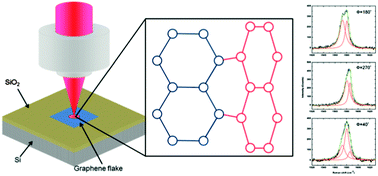Revealing anisotropic strain in exfoliated graphene by polarized Raman spectroscopy†
Abstract
We report on a polarized Raman study on mechanically cleaved single-layer

Maintenance work is planned from 09:00 BST to 12:00 BST on Saturday 28th September 2024.
During this time the performance of our website may be affected - searches may run slowly, some pages may be temporarily unavailable, and you may be unable to access content. If this happens, please try refreshing your web browser or try waiting two to three minutes before trying again.
We apologise for any inconvenience this might cause and thank you for your patience.
* Corresponding authors
a
Department of Photonics, National Cheng Kung University, Tainan 70101, Taiwan
E-mail:
chihiliu@mail.ncku.edu.tw
Fax: +886-6-2095040
Tel: +886-6-2363243
b Institute of Atomic and Molecular Sciences, Academia Sinica, P.O. Box 23-166, Taipei 10617, Taiwan
c Advanced Optoelectronic Technology Center, National Cheng Kung University, Tainan 70101, Taiwan
d Center for Condensed Matter Sciences, National Taiwan University, Taipei 10617, Taiwan
e Institute of Microelectronics, National Cheng Kung University, Tainan 70101, Taiwan
f Department of Electrical Engineering, National Cheng Kung University, Tainan 70101, Taiwan
We report on a polarized Raman study on mechanically cleaved single-layer

 Please wait while we load your content...
Something went wrong. Try again?
Please wait while we load your content...
Something went wrong. Try again?
C. Huang, R. Shiue, H. Chui, W. Wang, J. Wang, Y. Tzeng and C. Liu, Nanoscale, 2013, 5, 9626 DOI: 10.1039/C3NR00123G
To request permission to reproduce material from this article, please go to the Copyright Clearance Center request page.
If you are an author contributing to an RSC publication, you do not need to request permission provided correct acknowledgement is given.
If you are the author of this article, you do not need to request permission to reproduce figures and diagrams provided correct acknowledgement is given. If you want to reproduce the whole article in a third-party publication (excluding your thesis/dissertation for which permission is not required) please go to the Copyright Clearance Center request page.
Read more about how to correctly acknowledge RSC content.
 Fetching data from CrossRef.
Fetching data from CrossRef.
This may take some time to load.
Loading related content
